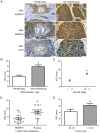Overexpression of A disintegrin and metalloprotease 10 promotes tumor proliferation, migration and poor prognosis in hypopharyngeal squamous cell carcinoma
- PMID: 28656294
- PMCID: PMC5562066
- DOI: 10.3892/or.2017.5761
Overexpression of A disintegrin and metalloprotease 10 promotes tumor proliferation, migration and poor prognosis in hypopharyngeal squamous cell carcinoma
Abstract
The aim of this study was to determine the effect of A disintegrin and metalloprotease 10 (ADAM10) protein expression on the progression, migration and prognosis of hypopharyngeal squamous cell carcinoma (HSCC). Immunohistochemistry and western blot analysis were performed to detect ADAM10 expression in human HSCC specimens. Cell Counting Kit-8 (CCK-8) assay, flow cytometry analysis and wound-healing assay were employed to investigate the effects of ADAM10 knockdown (ADAM10-RNAi) on major oncogenic properties of FaDu cells. We detected that ADAM10 was overexpressed in HSCC specimens and its expression level was associated with differentiation (p<0.001), tumor size (p=0.019), lymph node metastasis (p=0.001), clinical stage (p<0.001), proliferation marker Ki-67 expression (P=0.001) and overall survival (p<0.046). ADAM10-RNAi in FaDu cells resulted in the inhibition of proliferation and the decrease in migration. Moreover, mechanistic experiments revealed that ADAM10-RNAi resulted in an increase in E-cadherin and a decrease in N-cadherin and vimentin expression. Our study implies that high expression of ADAM10 promotes the proliferation and migration of HSCC. These findings may help to provide a method for treatment of HSCC.
Figures






Similar articles
-
Stathmin1 overexpression in hypopharyngeal squamous cell carcinoma: A new promoter in FaDu cell proliferation and migration.Int J Oncol. 2017 Jan;50(1):31-40. doi: 10.3892/ijo.2016.3778. Epub 2016 Nov 23. Int J Oncol. 2017. PMID: 27878293 Free PMC article.
-
FoxM1 overexpression promotes cell proliferation and migration and inhibits apoptosis in hypopharyngeal squamous cell carcinoma resulting in poor clinical prognosis.Int J Oncol. 2017 Oct;51(4):1045-1054. doi: 10.3892/ijo.2017.4094. Epub 2017 Aug 9. Int J Oncol. 2017. PMID: 28848994 Free PMC article.
-
MicroR-140-5p suppresses tumor cell migration and invasion by targeting ADAM10-mediated Notch1 signaling pathway in hypopharyngeal squamous cell carcinoma.Exp Mol Pathol. 2016 Feb;100(1):132-8. doi: 10.1016/j.yexmp.2015.12.008. Epub 2015 Dec 15. Exp Mol Pathol. 2016. PMID: 26704053
-
PCDH20 acts as a tumour-suppressor gene through the Wnt/β-catenin signalling pathway in hypopharyngeal squamous cell carcinoma.Cancer Biomark. 2019;26(2):209-217. doi: 10.3233/CBM-190442. Cancer Biomark. 2019. PMID: 31450490
-
Novel Approaches and Challenges of Discovery of Exosite Modulators of a Disintegrin and Metalloprotease 10.Front Mol Biosci. 2020 May 6;7:75. doi: 10.3389/fmolb.2020.00075. eCollection 2020. Front Mol Biosci. 2020. PMID: 32435655 Free PMC article. Review.
Cited by
-
ADAM10 promotes cell growth, migration, and invasion in osteosarcoma via regulating E-cadherin/β-catenin signaling pathway and is regulated by miR-122-5p.Cancer Cell Int. 2020 Mar 30;20:99. doi: 10.1186/s12935-020-01174-2. eCollection 2020. Cancer Cell Int. 2020. PMID: 32256208 Free PMC article.
-
Metformin Inhibits the Development of Hypopharyngeal Squamous Cell Carcinoma through Circ_0003214-Mediated MiR-489-3p-ADAM10 Pathway.J Oncol. 2021 Jul 13;2021:2265475. doi: 10.1155/2021/2265475. eCollection 2021. J Oncol. 2021. PMID: 34335751 Free PMC article.
-
Impact of ADAM10 gene polymorphisms on hepatocellular carcinoma development and clinical characteristics.Int J Med Sci. 2018 Aug 10;15(12):1334-1340. doi: 10.7150/ijms.27059. eCollection 2018. Int J Med Sci. 2018. PMID: 30275760 Free PMC article.
References
-
- Ligier K, Belot A, Launoy G, Velten M, Bossard N, Iwaz J, Righini CA, Delafosse P, Guizard AV. network Francim: Descriptive epidemiology of upper aerodigestive tract cancers in France: Incidence over 1980–2005 and projection to 2010. Oral Oncol. 2011;47:302–307. doi: 10.1016/j.oraloncology.2011.02.013. - DOI - PubMed
-
- Takes RP, Strojan P, Silver CE, Bradley PJ, Jr, Haigentz M, Jr, Wolf GT, Shaha AR, Hartl DM, Olofsson J, Langendijk JA, et al. International Head and Neck Scientific Group: Current trends in initial management of hypopharyngeal cancer: The declining use of open surgery. Head Neck. 2012;34:270–281. doi: 10.1002/hed.21613. - DOI - PubMed
MeSH terms
Substances
LinkOut - more resources
Full Text Sources
Other Literature Sources
Research Materials
Miscellaneous

